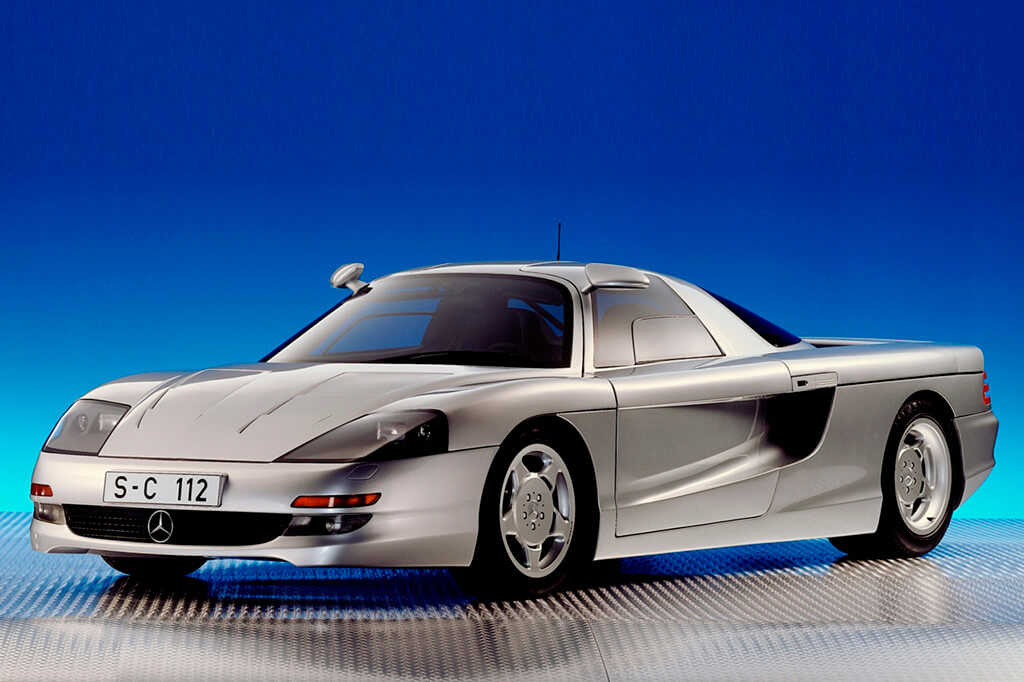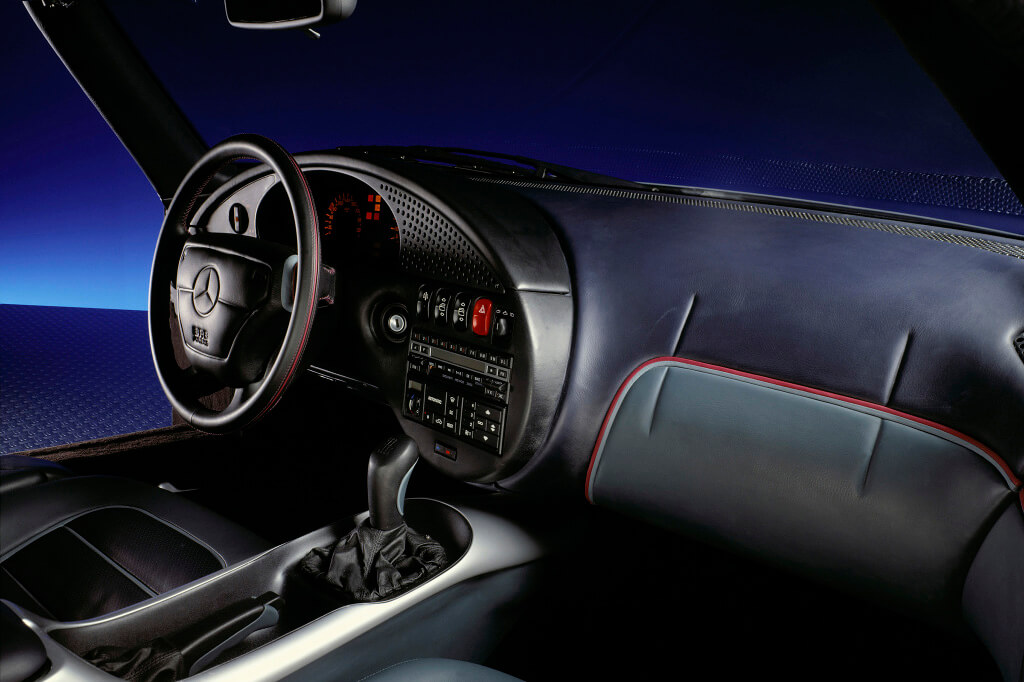Mercedes-Benz C112 Concept
Description
At the International Motor Show Germany in 1991, the Mercedes-Benz C112 Concept was presented – a true two-seat centrally-engine "supercar" with active aerodynamics and gullwing doors, capable of speeds of over 300 kph, and which was supposed to be a road version of the Sauber-Mercedes C11 (Group C) racing car. As a result, the prototype was used to test the latest electronic systems: Active Body Control (computer controlled suspension based on road conditions), brake pressure distribution (ASR) and anti-lock brake system (ABS), tire pressure monitoring, adaptive cruise control.
Development
The management of this project was entrusted to the DAS department, an elite department created in 1989 for cutting-edge design projects with the mission of exploring new paths in mobility and design. According to the most basic ideology of Mercedes, in the face of superior performance, the C112 had to be manageable, safe and comfortable. At the head of the project, Carl Leschke, together with his team, defined the sculptural forms of the Mercedes-Benz C112: clean and architectural forms, intricately sculpted on the sides and rear. The body was built in Turin by Carrozzeria Coggiola on a chassis supplied by Mercedes-Benz. The stylistic concept is also emphasized by the gullwing doors, which are reminiscent of the legendary 300 SL Gullwing: the brand's most iconic sports car.
Despite receiving about 700 orders, Mercedes management refused to mass-produce a sports car, despite the fact that there were even attempts to establish production together with Sauber.
Engine
Considering that the C112, in particular, was planned as a road version of the Sauber-Mercedes C11 (Group C) racing model, it received not a 5-liter twin-turbo V8 with a capacity of 750 hp, but an improved production M120 engine from the Mercedes-Benz SL600 model. The 6-liter V12 engine developed 408 hp. and 580 N∙m of torque, and according to calculations, should have allowed the prototype to accelerate to 100 kph in 4.9 s and reach a maximum speed of 310 kph.
The engine block was made of aluminum alloy and the cylinder bores were plated with nickel, which was unusual for road engines. Exhaust gases were expelled by a twin tailpipe exhaust system that included a pair of bi-directional three-way catalytic converters located near the engine.
Transmission
Power was sent to the rear wheels via a 6-speed manual gearbox.
Chassis
In addition to active aerodynamic elements, the prototype had an Active Body Control system to control the stability of the car through active springs and hydraulics on each wheel, as well as motion sensors. The computer, receiving information from the sensors, adjusted the suspension accordingly. There was an independent wishbone suspension at the front, a five-link suspension at the rear, similar to the Mercedes-Benz 190.
The wheel arches housed 17-inch wheels with five-spoke magnesium alloy wheels manufactured by Speedline. They were fitted with Michelin and Goodyear radial tires, 235/45 R17 at the front and 335/35 R17 at the rear.
The car also received active steering called "cybernetic". It corrected for directional deviation, which could be caused, for example, by ruts and side winds or a road surface with varying tire grip.
Brake system
The 4-piston Brembo brake system had cast iron ventilated brake discs measuring 332 mm at the front and 304 mm at the rear. In addition, the prototype was equipped with the latest generation of anti-lock braking system (ABS) and brake pressure distribution (ASR).
Exterior
The prototype was designed in the company's conservative style with an emphasis on sportiness and manufacturability. As the first car since the C 111, it had servo-powered gullwing doors. Since the 1950s, they have been the symbol of Mercedes-Benz sports cars. The prototype was also equipped with active and passive elements to improve aerodynamics and driving stability. Designers abandoned the use of retractable headlights, which could destabilize the car at high speeds and worsen the drag coefficient. The headlights of the model were hidden behind transparent fairings, as on the C111-III prototype. To maintain low aerodynamic drag, only three air intakes were installed on the car: one on each side and one in the front. Side air intakes supplied cooling air to the engine compartment. Part of the air was directed to the rear brakes. Cooling air for the front brakes came from an air intake located at the front of the car for the engine radiator.
The active elements of aerodynamics were rear and front spoilers, which were able to move, thereby increasing downforce at high speeds and turns. The estimated downforce of the C112 was about 1,000 kilograms at a speed of 306 kph.
The aluminum body structure was designed to deform on impact to absorb impact energy. The drag coefficient of the Mercedes-Benz C112 was 0.30.
Also, the prototype did not provide for either a luggage compartment or a special space for a spare wheel.
Interior
The interior of the prototype received a luxurious, leather, traditional for more expensive and flagship products of the company. The driver and passenger had two passenger seats, cruise control, power windows, a Becker Mexico 2000 stereo cassette system and climate control. To ensure the comfort of the passengers of the model, improved sound insulation was used.
Other systems tested in the C 112 are tire pressure monitoring, which warned the driver of a sudden loss of pressure, radar warning of the distance to vehicles ahead, and so on.
Sources
Specification
| Bodywork | |
|---|---|
| Presentation | |
| Years of production |
1991
|
| Body type |
купе
|
| Number of doors |
2
|
| Number of places |
2
|
| Engine | |
|---|---|
| Engine type |
бензиновый
|
| Engine location |
центральное, продольное
|
| Engine model |
Mercedes-Benz M120
|
| Cylinders |
V12
|
| V-angle |
60°
|
| Cylinder operation |
1-12-5-8-3-10-6-7-2-11-4-9
|
| Capacity (cc) |
5987
|
| Power output (hp / kW /) |
408 /
304 /
|
| at rpm |
5200
|
| Torque (N·m) |
580
|
| at rpm |
3800
|
| Bore (mm) |
89,0
|
| Stroke (mm) |
80,2
|
| Compression |
10,0
|
| Number of valves |
4/48
|
| Valvetrain |
DOHC
|
| Block material |
алюминиевый сплав
|
| Engine weight (kg) |
300
|
| Oil sump capacity (l) |
9,5
|
| Cooling volume (l) |
11,0
|
| Fuel system |
впрыск
|
| Fuel system model |
Bosch LH-Jetronic
|
| Turbocharger |
—
|
| Specific | |
|---|---|
| Specific output (hp/litre) |
68,15
|
| Specific output (hp/tonne) |
260,37
|
| Specific output (kg/hp) |
3,84
|
| Specific torque (N·m/litre) |
96,88
|
| Specific torque (N·m/tonne) |
370,13
|
| Transmission | |
|---|---|
| Driven wheels |
задний
|
| Gearbox model |
Mercedes-Benz
|
| Gearbox |
механическая
|
| Number of speeds |
6
|
| Final drive ratio |
2,930
|
| First gear ratio |
3,640
|
| Second gear ratio |
2,420
|
| Third gear ratio |
1,690
|
| Fourth gear ratio |
1,240
|
| Fifth gear ratio |
1,030
|
| Sixth gear ratio |
0,810
|
| Reverse gear ratio |
3,360
|
| Suspension | |
|---|---|
| Front suspension |
независимая на двойных поперечных рычагах
|
| Rear suspension |
независимая многорычажная
|
| Elastic elements in front |
пружины
|
| Elastic elements in rear |
пружины
|
| Front anti-roll bar | |
| Rear anti-roll bar | |
| Wheels brand |
Speedline
|
| Wheel size front |
8,5J×17
|
| Wheel size rear |
13,0J×17
|
| Tire brand |
Michelin
|
| Tyres front |
235/45 R17
|
| Tyres rear |
335/35 R17
|
| Steering | |
|---|---|
| Steering type |
шестерня-рейка
|
| Power steering |
да
|
| Steering wheel turns |
3,3
|
| Brakes specs | |
|---|---|
| Brakes front |
дисковые вентилируемые
|
| Brakes rear |
дисковые вентилируемые
|
| Brand of brakes |
Brembo
|
| Front brake diameter (mm) |
332
|
| Rear brake diameter (mm) |
304
|
| Disc material |
чугун
|
| Number of caliper pistons (front/rear) |
4/4
|
| Anti-lock braking system |
да
|
| Dimensions and weight | |
|---|---|
| Body |
стальной трубчатый каркас
|
| Body material |
алюминий
|
| Length (mm) |
4616
|
| Width (mm) |
1976
|
| Height (mm) |
1195
|
| Wheelbase (mm) |
2700
|
| Front track (mm) |
1600
|
| Rear track (mm) |
1625
|
| Drag coefficien |
0,300
|
| Curb weight (kg) |
1567
|
| Trunk volume max (litre) |
0
|
| Performance specs | |
|---|---|
| Ecological class |
Евро 2
|
| CO₂ emissions (NEDC) (g/km) |
370
|
| Fuel tank capacity (l) |
100
|
| Fuel type |
Аи-95
|
| Dynamic specs | |
|---|---|
| Acceleration 0-100 kph (s) |
4,9
|
| Top speed (kph) |
310
|
|---|---|
| Top speed (mph) |
193
|
| Tags: | |
|---|---|
| Type: | |
| Brand: | |
| Country: |



